Preview: Field of Glory II
Before it was revamped with the new engine in 2016, Field of Glory (from 2011) was already the epitome of ancient warfare for the PC.
Disclaimer: Yes, I was one of the guys that bought every expansion for the original, just as quickly as they came out. So I was beyond ecstatic when I got the opportunity to review Field of Glory II!
The official description states, “Field of Glory II is a turn-based tactical game set during the Rise of Rome from 280 BC to 25 BC.”. However, with this current system, it is so very much more than that.
Bringing 48 nations and factions to the new 3D engine, Field of Glory II has so many options for scenarios and campaigns it will be literally impossible for me to catalog them all. However, I will do my best to try to give a basic overview of a few, as well as listing my favorites along the way, after all with 48 nation possibilities there comes 75 different armies!
The game is turn-based on a square grid structure which allows your units eight possible facings. The direction a unit is pointed makes a huge impact on the determination of all factors of movement and, especially, combat. Knowing that a particular troop may be involved in the next round of fighting, do you move the extra square or two or do you not take as much ground, leaving you the opportunity to pivot to the direction that you want to be facing when it is the enemy’s turn?
Included in the decision-making process, like any great wargame, is the terrain. Having a height advantage, for both offensive and defensive positions, is something that you should not take lightly. Likewise, using any kind of troops that can benefit from enclosures, woods, built-up areas, or any other type of obstacles, can sway the tide of battle in your favor – or be detrimental, should you be on the wrong side of the impediment.
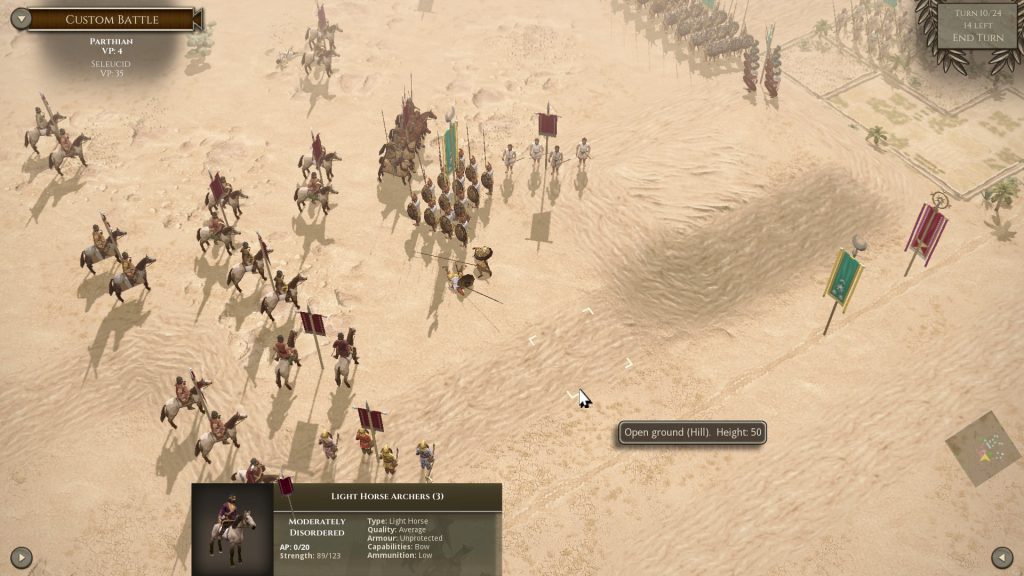
To start the battle choices, from simplest to most complex, Field of Glory II ships with predetermined Quick Battles. These are smaller skirmishes for you when you just need a quick taste to satiate your ancient conflict needs. The easiest and fastest way to get into a battle is to hit the “Fight Now!” button. The game quickly and immediately takes care of all of your decisions: the scenario, the two opposing forces, the map, and the victory goals. It is as simple as that. (My first try gave me Carthaginian v Roman, while my second one brought me Parthian v Armenian.)
If you need a little more control, you simply hit the “Quick Battles” button. This will give you the opportunity to choose both you and your opponent’s sides, as well as the conflict. After you have chosen your side, depending on who you picked, the menu will then give you a historically accurate set of viable adversaries. Logically then, if you choose a lesser-known entity, say the Macedonians, you will have fewer foes to choose from (in their case, only Rome). However, choosing someone with a more broadened history as your side will give you more options for challengers. (for example, if you choose to play as Rome, your enemy choices are the Ancient British, Armenian, Carthaginian, Gallic, etc. – with eleven possible opponents).

While still in Battles mode, we come to the first of my favorites in Field of Glory II: Custom Battles. This is where things really open up! You first pick your army. Then, you can choose any army to go into the fray against. There are plenty of filters to find the ‘right’ possible enemy for you including alphabetically, by date, and also by three different sets of geographic locations. The best part for me though is the ability to shut off the historic filters (namely the date and geography) so you can have access to all of the armies provided within the game! So, the Germanic Foot Tribes (105 BC – 259 AD) may have only geographically run into 19 of the game’s provided armies. But, if you want them to fight against, say, the Bithynian Army (of 297 – 74 BC fame), then you can absolutely set that up! Another option for one or both sides is “Pot Luck” – meaning the force(s) will be randomly chosen for you.
Once you have chosen the armies for war, next you choose the scenario type. Your options are: “Open Battle” where both sides are prepared to fight; “Enemy Reinforcements” is where you start outnumbering them, but, as you have all of your units for the battle, the enemy will be receiving more; Reinforcements is when your side starts with the disadvantage but will get reinforcements later on; “Send Flank March” is where you have split your forces and are trying to outflank his entire, grouped army (note: be careful with this one! we all know the results of trying to fight a two-front war); “Rearguard” in which is you are extremely outnumbered, just trying to slow his army for as many turns as possible; “Advance Guard” is when both (advance) armies are on the march and accidentally run into each other, and both of you are just trying to hold out until nightfall, (when theoretically, both main forces arrive); “Remove the Head” is where you are aiming specifically to take out his Commander-in-Charge (you need to realize that is his goal as well) and finally, “Escort Baggage Train” where you are moving through his (the enemy’s) territory with a baggage train. Your goal is to get at least half of it to the other side of the map.
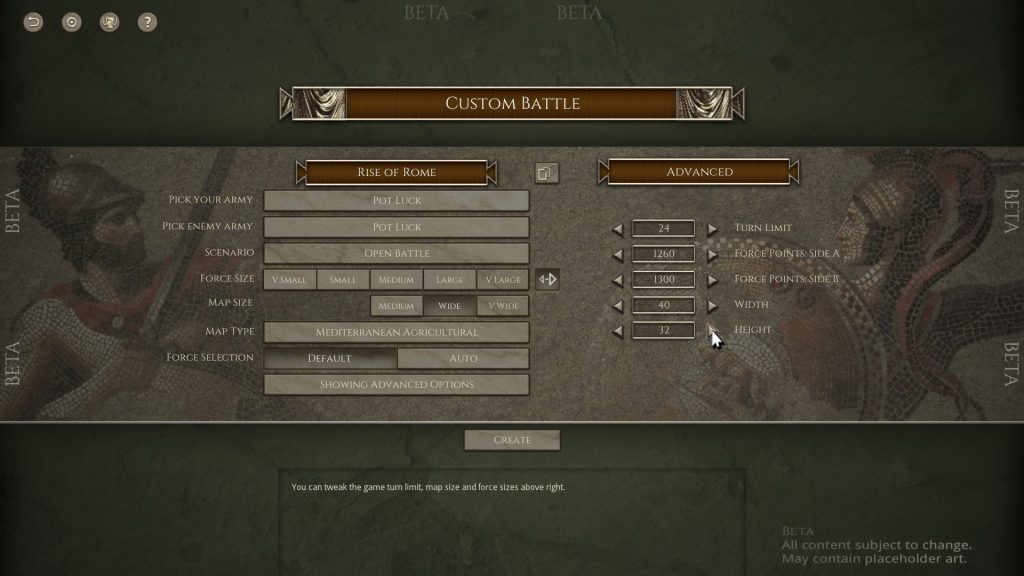
Whew! That is not all of the options yet. Next, you choose force size(s) which range from very small to very large. Map size’s options are Medium, Large, and Very Large. Fifteen map types to pick from. (Huge note here: all of the maps, while staying within the qualifications for size and type, are randomly generated each time!). There are some Advanced Options as well that deal with force size, custom map sizes, and turn limits. The last option is whether you want to make all of the decisions pertaining to your forces or have the engine automatically choose for you.
The final types of battle conflict are the Epic Battles. Field of Glory II comes with 12 pre-constructed historical scenarios of, obviously, epic proportions. These range from 255 BC to 49 BC; from the Carthaginian-Roman Battle of Bagradas to the Caesarian and Pompeian Battle of Thapsus. Firing up any one of these is awe-inspiring in size and scope, to say the least. You must come prepared to make a plethora of decisions if you plan to strategize for any battle of this magnitude.
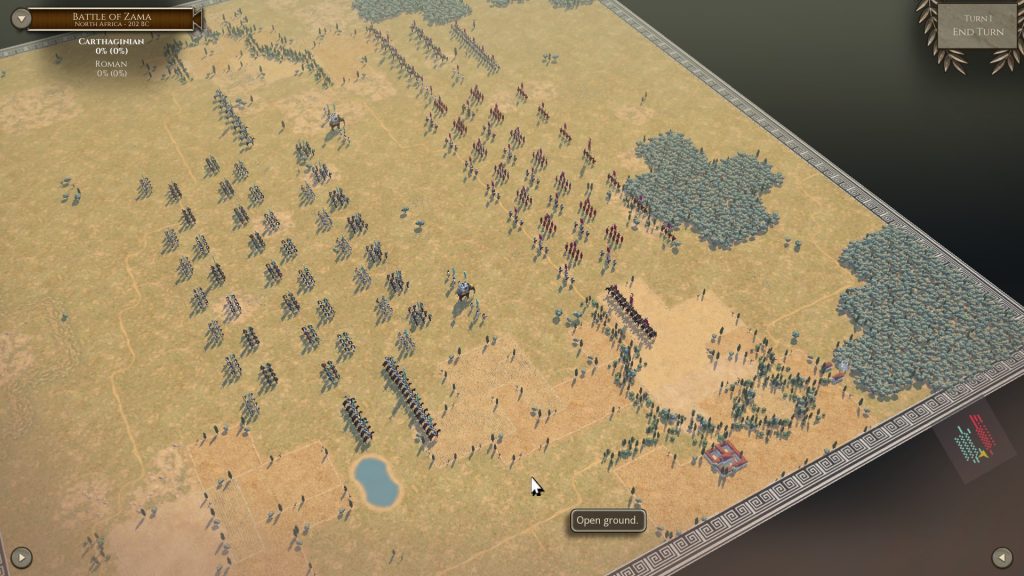
Here then, we finally come to the campaigns! In campaigns, you have core units that stay with you from one battle to the next. As your army progresses, they gain confidence and experience from fight to fight – provided that you are victorious.
Field of Glory II ships with four preset campaigns that follow a historical narrative of an ancient general. These are Julius Caesar, Hannibal, Mithridates the Great, and Pyrrhos of Epeiros. They will fight multiple enemies, sometimes with, or sometimes without allies, over a series of battles.
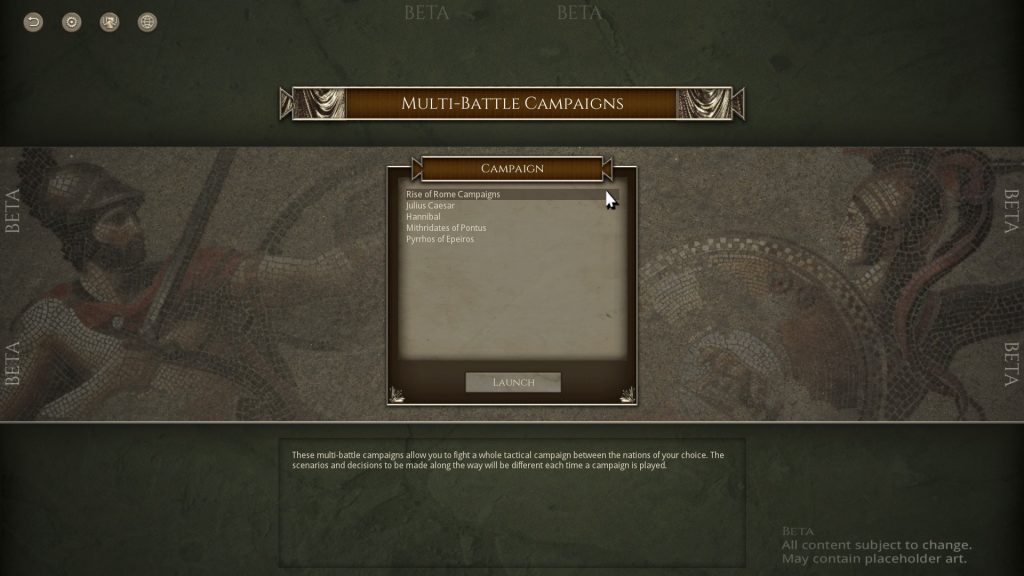
Rule Number One for victory: your leader cannot die! If he dies, you lose. You also have to win each fight along the way in order to progress to the next conflict of the campaign. If you lose one battle, you must replay that stage of the campaign until you are victorious in order to proceed to the next battle. Also, your judgement about the amount of victory comes into play as well. If you win a stage, but you feel like it wasn’t by quite enough, you have the option of replaying it before moving on to the next phase.
Why would you want to do that? Because your losses during battle are replaced by recruitment between fights. If you win decisively, then you will have no problems recruiting and refilling units for the next fray. However, if you lose more than 15% of your troops, your recruitment points will drop increasingly, for each percentage over that mark. So, you can win a stage of a campaign, but it may be better to replay it if you either only won by a small margin or you took heavy losses while achieving the victory. The final kick in the backside of your armor is that the enemy armies are newly generated for each battle.
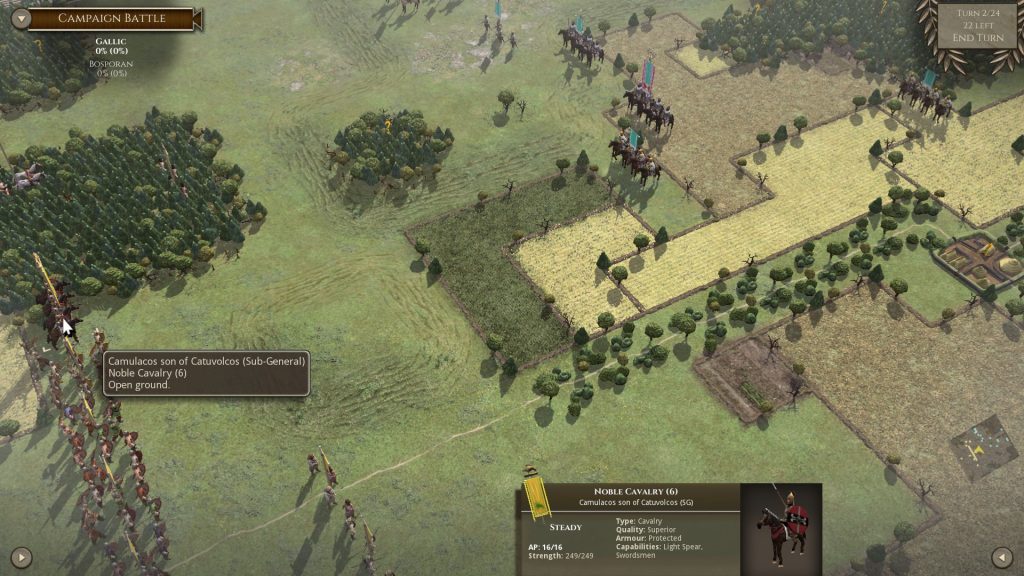
Now, to my absolute favorite part of the entire Field of Glory II system: Custom Campaigns! On the top of the campaign screen, above the four that I already mentioned is a top one titled “Rise of Rome Campaigns”. This is the custom campaign generator. Here is where you choose the two armies that are going to go through linked battles (again with either or both being “Pot Luck”), with the core armies, all of the described campaign parts, etc. Just like with the custom battles, you can filter the armies as you wish, or not at all.
Your choices are three, five, or seven skirmishes for the campaign. You choose your first battle size: from very small to large; then your last battle size: from medium to very large. You then pick your overall difficulty level, from I to VI. Finally, the last choice to be made is “Tribune”. The first button is “Static”, meaning that the difficulty will remain the same throughout the entirety of the campaign. The other/second button is the really interesting one, labeled “Progressive”. This means that the difficulty scales up by one for each new battle! So, with everything else you have to worry about, the enemy will be tougher each step of the way. Once everything is set, you simply click “Create” and your custom campaign is formed. Way. too. cool.
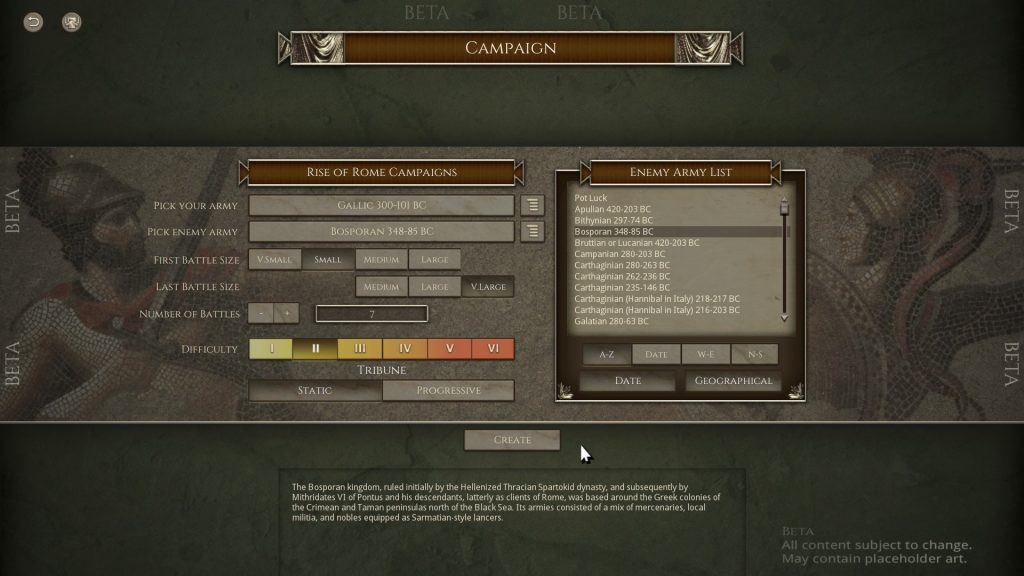
Never have I started a wargame review by talking about graphics. Field of Glory II could have been the exception. When I first started it, plus having all of that original Field of Glory experience, I sincerely did not know how to (re)act. The graphical overhaul is astounding. There are “86 historically accurate units, built from fully animated 3D troop models, each with many variants.” There is a very wide range of types of troops. They have, from their own description, “Roman legionaries before and after the reforms of Marius, Greek hoplite and Carthaginian African spearmen, Hellenistic pike phalanxes, thureophoroi spearmen and xystophoroi lancers, Gallic warbands, Skythian horse archers, Sarmatian lancers, Roman, Carthaginian, Greek and Gallic spear-armed cavalry, war elephants, Celtic and Indian chariots, scythed chariots, a wealth of light troops and many many more.”
I was completely blown away by the graphics. I knew they would be upgraded, sure, but I never expected these levels of detail and animation. Nobody stands still! Each unit is moving – all of the time, like they just cannot wait for you to change their position to put them into the fight. On top of that, they’re all yelling, varying by unit type. It is like ancient warfare trash-talking or something. ”Okay, I do see you standing there, I’ll put you in, here in a minute!”
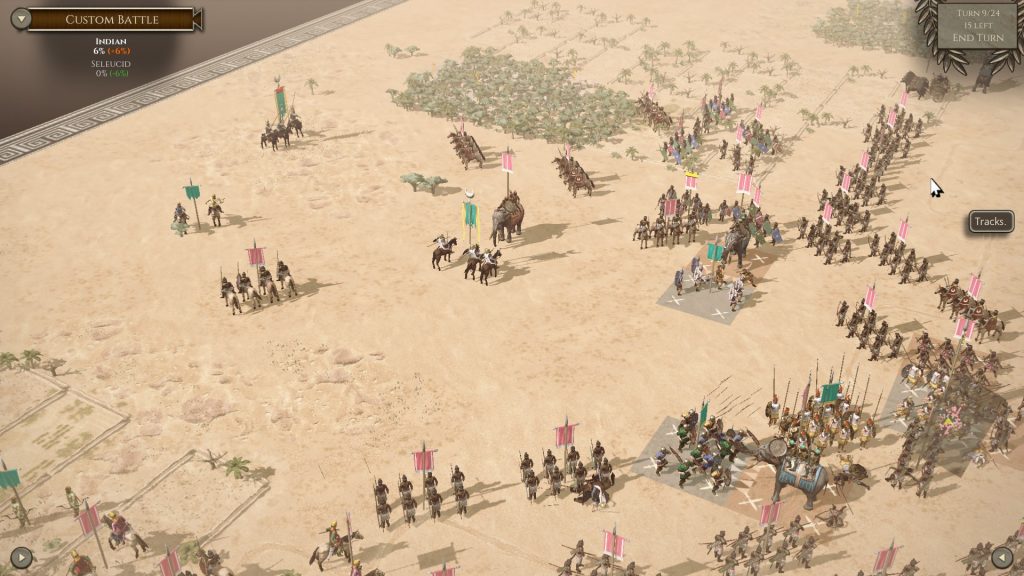
All of the flexibility that Field of Glory II brings is simply phenomenal. The gameplay is beyond incredible. The enemy AI is formidable, to say the least. Byzantine and Slitherine have outdone themselves with this title. I cannot wait to see what they add next. For now, though, I have to get back to my not-now-impossible, Gallic/Syracusan, seven-stage, progressive-difficulty campaign.
[Side note: If I remember correctly, this game engine started with Pike and Shot, then was used in Sengoku Jidai: Shadow of the Shogun before the current development of Field of Glory II]
Reviewed using v0.0.7 (Build 10009) (Beta) Exp: 26 Nov 2017












It is an excellent game and this is a great review. I think that the same engine (at a low level) was originally used in Battle Academy and then Pike and Shot etc.
Thank you for the kind words! I couldn’t remember for certain if it was the “Battle Academy” engine or not. Just knew for sure that it was “Pike and Shot” and beyond.